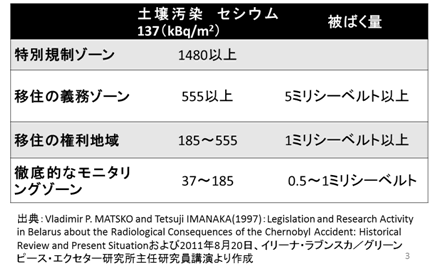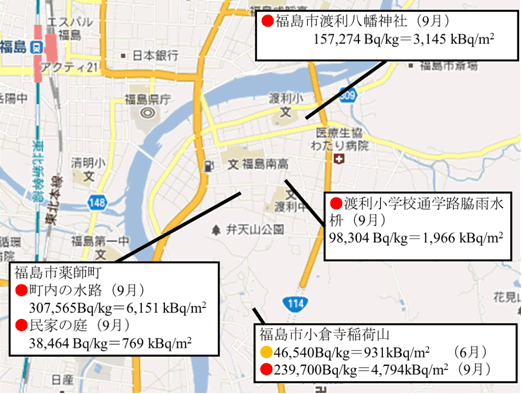A Summary Report:
Soil Contamination Levels in Watari, Fukushima City
October 5, 2011
Citizens Against Fukushima Aging Nuclear Power Plants (Fukurou-no-Kai)
Friends of the Earth Japan (FoE Japan)
1.Introduction
Today, the government is deliberating whether to designate Watari, Oguraji, and Nankodai in Fukushima City as special evacuation points. The survey by Fukushima City in June 2011 found high levels of radiation in broad areas of Watari, but the government took no action to deal with the situation. Moreover, while the Headquarters for the Atomic Power Disaster and the prefectural government of Fukushima conducted a detailed survey of radiation levels in Fukushima in late August, they surveyed only a part of Watari and measured only the amount of radiation in the air. It is therefore unclear whether the government would take into account potentially serious contamination of soil in designating special evacuation points. This means that Watari residents outside special evacuation points may face various difficulties; for example, they may not be able to receive monetary compensations for voluntarily evacuating to escape high levels of radiation. To solve this problem, Fukurou-no-Kai and FoE Japan asked Professor Tomoya Yamauchi (Radiation Science and Application Laboratory, Kobe University) to conduct a survey of radiation levels in Watari on September 14. (For levels of radiation in the air, please refer to our previous summary report issued on September 20.)
2.Findings
·We sampled five points of soil in Watari and Oguraji. We used a modest conversion factor of 20 in calculating the amount of cesium in soil per square meter. Four out of the five sampled points showed levels of radiation equivalent to the zone of evacuation (alienation) in Chernobyl, and one equivalent to the zone of resettlement.
A Comparison of Radiation Levels Observed in Fukushima City and the Chernobyl Zones*1
Bq/kg
(measured)
kBq/m2
(conversion factor = 20)
Equivalent of the Chernobyl Zones
Oguraji Inariyama
239,700
4,794
Evacuation(greater than 1,480kBq/m2)
Yahata Shrine
157,274
3,145
Evacuation(greater than 1,480kBq/m2)
A rain collector along a route to Watari Elementary
98,304
1,966
Evacuation(greater than1,480kBq/m2)
An aqueduct in Yakushi
307,565
6,151
Evacuation(greater than1,480kBq/m2)
A yard in Yakushi
38,464
769
Resettlement(greater than 555kBq/m2)
●
:Resettlement zone:555 kBq/m2~1480 kBq/m2
●
:Evacuation zone:greater than 1480kBq/m2
-
In Oguraji, we sampled soil from the same point that we had examined in our previous survey in June. We found that the radiation level had increased. We think that surrounding trees and hills feed contaminated soil to the area when it rains. Given this physical environment, rain does not decrease a radiation level by dispersing radioactive materials. We believe that the same mechanism operates in Watari and other areas to increase radiation levels.
-
The level of soil contamination equivalent to the zone of evacuation in Chernobyl was found around a rain collector and a dried aqueduct along routes that children use to go to school as well as a yard of Yahata Shrine where children spend their time playing after school.
-
The aforesaid rain collector is situated across the street from the ditch where Fukushima City removed mud during their cleanup campaign.
-
Except for Oguraji, the places that we surveyed fall outside the scope of the detailed survey that the government conducted in designating special evacuation points.
3.Our Demands
In light of these findings, we repeat the following demands on the Japanese government and the prefectural and city governments of Fukushima.
1) The high level of soil contamination was found in children’s daily environment. Since trees and hills enclosing Watari continue to feed contaminated soil to the area, radioactive material are likely to get concentrated rather than dispersed. Given this physical environment, removing mud from ditches provides only a temporary solution. The governments should evacuate children until cleanup efforts produce satisfactory results.
2) Our survey indicated that soil contamination encompasses the entire area of Watari. In light of lessons from the Chernobyl disaster, the governments should include a level of soil contamination into criteria for designating special evacuation points.
3) Given that the surrounding trees and hills feed contaminated soil to Watari and increase radiation levels every time it rains, the governments should designate the entire township as a special evacuation zone.
4) Finally, the current criterion for designating special evacuation points (20mSv/year) is too high, compared to existing laws in Japan.*2 The governments should therefore modify the criterion and expand areas eligible for monetary compensations and administrative support to facilitate evacuation.
Notes
*1) The Chernobyl Zones:

*2) 20µSv/year is four times as high as the criterion for radiation controlled areas (5.2mSv/year) and twenty times as high as the one for the public (1mSv/year).
to TOP



